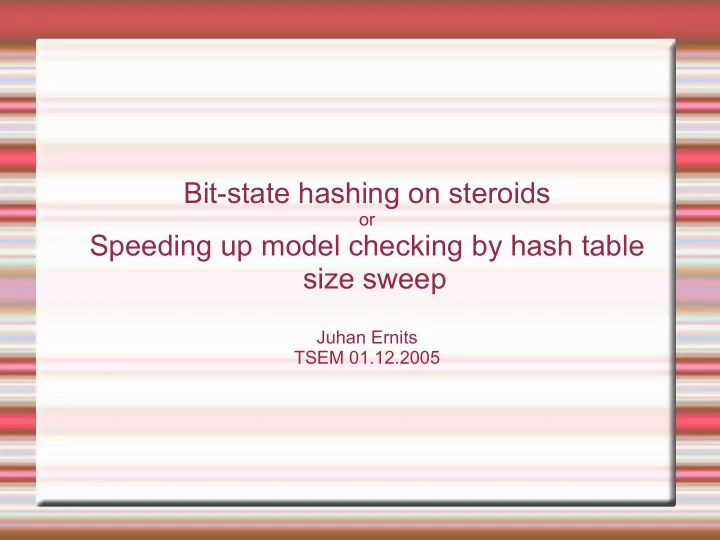

Bit-state hashing on steroids or Speeding up model checking by hash table size sweep Juhan Ernits TSEM 01.12.2005
What do we want to do? We want to check for reachability on a structure representing a constraint system. (this is equivalent to) We want to check if the behaviour of the model is included in the behaviours of the specification
Example
Explicit state model checking We consider explicit state model checking. all control states and data states are represented explicitly. As opposed to symbolic model checking where the states are represented by some symbolic construct, for example BDD-s.
Ways of reducing memory Partial order reduction Lossless state compression Collapse compression Minimized automaton representation Lossy state compression bit-state hashing hash compaction
Collapse compression The state explosion is due to small changes in many places Store different parts of the state space in separate descriptors and represent the actual state as an index to relevant state descriptors
Minimized automaton representation Build a recognizer automaton for states. All states that have been seen lead to an accepting state. The recognizer automaton is interrogated on each step of the model checker. The recognizer automaton is modified each time a new state is seen.
What is hash compaction A method where each state is represented by a hash (for example 128 bits). This is stored in a regular hash table. Used in Spin, Zing, Bogor, ... Can achieve very good coverage.
Bit-state hashing Let us look at how a hash table works. Instead of a state, store one bit.
Hash functions mod sucks! Look at Jenkins' hash funcion: // Most hashes can be modeled // like this: initialize(internal state) for (each text block) { combine(internal state, text block); mix(internal state); } return postprocess(internal state);
Hash functions 2 Hash functions are well researched to be as pseudorandom as possible. Can we do better? Can we encode some relevant simple abstraction function into the hash function?
Hash table size sweep Start with a really small hash table size and modify the size of the table while keeping the hash function constant. Works well for synthesis tasks task failed with exceeding 3 GB of mem in the explicit case; worked with 100 MB of memory with bit state hashing enabled, but
Hash table size sweep Percentage of queries yielding a trace to the desired state (not “may be”).
Hardware vs software checking Hardware in general has a lot of control states and relatively few data variables Software has loooots of data and weird constructs like threads, dynamic creation of objects, garbage collection ... One has to be really careful when attemting to use bit-state hashing for software.
Ideas By modifying the size of the hash table we got an answer to the query in seconds and by using a few kilobytes for the hash table. The cache memory of modern processors is 1-2 MB. This should make such sweep really fast.
Help needed!!! To write an extension to Bogor (remember John Hatcliff?) Experiment with hash table size sweep on BIR examples. Put it all into a paper and produce a (preferably ISISISI) publication.
Recommend
More recommend